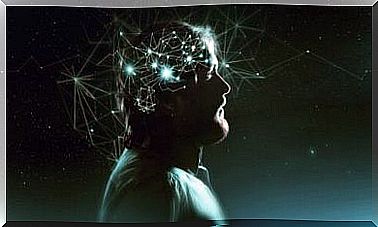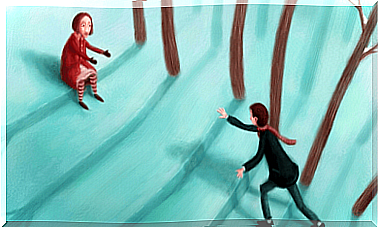Depersonalization Disorder: Who Am I Really?

“My thoughts don’t seem mine”, “Who am I?”, “When I look in the mirror, I don’t recognize myself”. These kinds of thoughts occur very frequently in people with depersonalization disorder or who are going through moments of great anxiety.
The search for one’s own identity and one’s place in the world is a constant. We have all wondered at times who we are, where we come from and where we are going. It’s a normal thing. However, in depersonalization disorder it occurs with much more frequency and intensity .

What is depersonalization?
Depersonalization disorder is characterized by persistent or recurrent episodes of depersonalization, derealization, or both. But what is depersonalization? Episodes of depersonalization are moments in which a feeling of unreality, strangeness or a detachment from oneself and from the outside world in general appears .
The person affected by depersonalization may feel independent of his whole being and of what characterizes it (for example, “I am nobody”, “I have nothing of myself”). The person may also feel subjectively separate from some aspects of the ego. These can include feelings (for example low emotionality: “I know I have feelings, but I can’t feel them”).
Feeling separate from the ego also includes feeling a separation from one’s thoughts (for example, “I feel foggy”), parts of the body, the whole body or sensations (for example, touch, proprioception, hunger , thirst, libido). It is also common for the sense of reality to diminish.
For example, the person experiences a robotic sensation, like an automaton, which has little control over the use of speech and their movements. The experience of depersonalization can sometimes materialize in a split ego, with one part as an observer and the other as a participant. When it occurs in its most extreme form, it is known as an ” out of body experience “.
The common symptom of depersonalization is made up of several factors. These factors include abnormal bodily experiences (eg ego unreality and perception alterations), physical, emotional numbness, and time distortions with subjective memory abnormalities.

What is derealization?
Episodes of derealization are characterized by a feeling of unreality, detachment or unfamiliarity with the world. The person may feel as if in a dream or in a bubble, as if there is a veil or a glass wall between them and the world around them.
The environment can be seen as an artifact, devoid of color or life. Derealization is usually accompanied by subjective visual distortions. These can be blur, increased visual acuity, enlarged or reduced field of view, two-dimensional or flatness, exaggeration of three-dimensionality. Alterations in distance or size of objects may also occur (for example, macropsia or micropsia).
Macropsy consists of seeing objects larger than their actual size. Micropsy is the other way around, in other words we see objects smaller than they actually are.
Derealization can also result in auditory distortions, silencing or accentuating voices or sounds. To diagnose this disorder, the presence of clinically significant malaise or deterioration from a social, occupational, or other important area is required.
It should be clarified that, in order to be able to formulate a diagnosis of derealization, the alterations mentioned cannot be the result of the intake of medicines and drugs or of a disease (such as epilepsy). These changes don’t have to be symptoms of schizophrenia, panic attacks, major depression, acute stress disorder, or post-traumatic stress disorder either.
Additional characteristics of people with depersonalization disorder
People with depersonalization / derealization disorder may have a hard time describing their symptoms and may come to think that they are or are going crazy. Another common experience is the fear of irreversible brain damage.
A common symptom is the subjective alteration of the sense of time (for example, too fast or too slow), as well as a subjective difficulty in vividly recalling past memories and mastering them.
Milder body symptoms, such as saturation, tingling, or feeling faint, are also common. The person may show obsessive concern in trying to understand if they really exist or to check their perceptions to determine if they are real or not.
It is not uncommon to experience varying degrees of anxiety or depression in those with depersonalization disorder. A curious fact is that these people tend to react physiologically more intensely to emotional stimuli. These physiological changes occur following activation of the hypothalamic-pituitary-adrenal axis, the inferior parietal lobule, and the limbic prefrontal cortex circuits.

Diagnosis of depersonalization / derealization disorder?
According to the Diagnostic and Statistical Manual of Mental Disorders (DSM-V), the person with depersonalization / derealization disorder must meet the following diagnostic criteria:
A. Presence of persistent or recurring experiences of depersonalization, derealization, or both:
- Depersonalization: Experiences of unreality, detachment or being an external observer with respect to one’s thoughts, feelings, sensations, one’s body or one’s actions.
- Derealization: Experiences of unreality or detachment from the environment (for example, people or objects are seen as unreal, as in a dream: vague, lifeless or visually distorted).
B. During the experiences of depersonalization or derealization, the evidence of reality is kept intact.
C. Symptoms cause clinically significant distress or deterioration from a social, occupational, or other important point of view.
D. The alteration cannot be attributed to the physiological effects of a substance (eg drugs and medicines) or to another pathology (eg epilepsy).
E. The alteration is not due to another mental disorder, such as schizophrenia, panic attacks, major depression, acute stress disorder, post-traumatic stress disorder, or another dissociative disorder.
Development and course of depersonalization disorder
On average, depersonalization disorder begins to manifest around age 16, although it can begin in early or mid-childhood. In fact, most people remember having symptoms already at this stage.
More than 20% of cases appear after the age of 20 and only 5% after the age of 25. The appearance in the fourth decade of life or later is very unusual. The beginning can be extremely sudden or gradual. The duration of episodes of depersonalization / derealization can vary widely, from short (hours or days) to prolonged (weeks, months or years).
Given the rarity of the onset of the disorder after the age of 40, in these cases there may be underlying pathologies, such as brain lesions, seizures or sleep apnea.
The course of the disease is often chronic. While in some people the intensity of symptoms may increase or decrease considerably, others report a constant level in intensity which, in extreme cases, can be recurrent for years or decades. On the other hand, the increased intensity of symptoms can be caused by stress, worsening mood or anxiety, new stimulating circumstances or physical factors, such as light or lack of sleep.
It must be said that not all people who have some of these symptoms develop this disorder. If the symptoms mentioned are present most of the time and seriously interfere with your daily life, you may need to see a psychologist to evaluate your problem.

Bibliographical references
American Psychiatry Association (2014). Diagnostic and Statistical Manual of Mental Disorders (DSM-5), 5th Ed. Madrid: Editorial Médica Panamericana.









